Search the Special Collections and Archives Portal
Search Results
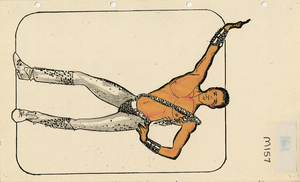
Costume design drawing, male dancer in silver tights, Las Vegas, June 5, 1980
Date
1980-06-05
Archival Collection
Description
Pete Menefee design. Handwritten on back of photo: "black disco boys." Transcribed from original drawing index: "8 black boys (silver tights)."
Costume Details: Male dancer wearing silver tights and rhinestone-studded boots, wrist cuffs, g-string, and shoulder strap.
Show Name: Jubilee!
Performance Name: Minstrel opening: Hullabaloo
Site Name: MGM Grand Hotel and Casino
Costume Details: Male dancer wearing silver tights and rhinestone-studded boots, wrist cuffs, g-string, and shoulder strap.
Show Name: Jubilee!
Performance Name: Minstrel opening: Hullabaloo
Site Name: MGM Grand Hotel and Casino
Image
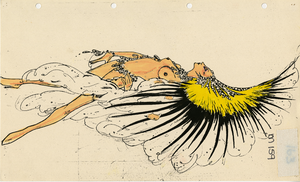
Costume design drawing, topless showgirl in yellow and black feathers #1, Las Vegas, June 5, 1980
Date
1980-06-05
Archival Collection
Description
Pete Menefee design. Transcribed from original drawing index: "tall nude girl (yellow & black feathers #1)."
Costume Details: Topless showgirl in jeweled g-string and headress with yellow, white, and black feathers.
Show Name: Jubilee!
Performance Name: Minstrel opening: Hullabaloo
Site Name: MGM Grand Hotel and Casino
Costume Details: Topless showgirl in jeweled g-string and headress with yellow, white, and black feathers.
Show Name: Jubilee!
Performance Name: Minstrel opening: Hullabaloo
Site Name: MGM Grand Hotel and Casino
Image
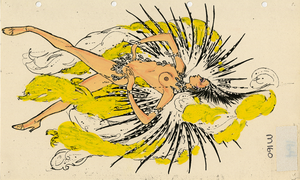
Costume design drawing, topless showgirl in yellow and black feathers #2, Las Vegas, June 5, 1980
Date
1980-06-05
Archival Collection
Description
Pete Menefee design. Transcribed from original drawing index: "tall nude girl (yellow & black feathers #2)."
Costume Details: Topless showgirl in jeweled g-string and headress with yellow, white, and black feathers.
Show Name: Jubilee!
Performance Name: Minstrel opening: Hullabaloo
Site Name: MGM Grand Hotel and Casino
Costume Details: Topless showgirl in jeweled g-string and headress with yellow, white, and black feathers.
Show Name: Jubilee!
Performance Name: Minstrel opening: Hullabaloo
Site Name: MGM Grand Hotel and Casino
Image
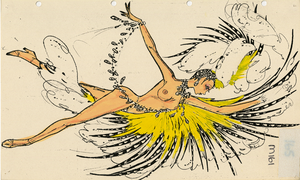
Costume design drawing, topless showgirl in yellow and black feathers #3, Las Vegas, June 5, 1980
Date
1980-06-05
Archival Collection
Description
Pete Menefee design. Transcribed from original drawing index: "tall nude girl (yellow & black feathers #3)."
Costume Details: Topless showgirl in jeweled g-string and headress with yellow, white, and black feathers.
Show Name: Jubilee!
Performance Name: Minstrel opening: Hullabaloo
Site Name: MGM Grand Hotel and Casino
Costume Details: Topless showgirl in jeweled g-string and headress with yellow, white, and black feathers.
Show Name: Jubilee!
Performance Name: Minstrel opening: Hullabaloo
Site Name: MGM Grand Hotel and Casino
Image
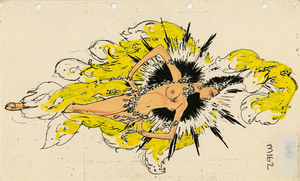
Costume design drawing,topless showgirl in yellow and black feathers #4, Las Vegas, June 5, 1980
Date
1980-06-05
Archival Collection
Description
Pete Menefee design. Transcribed from original drawing index: "tall nude girl (yellow & black feathers #4)."
Costume Details: Topless showgirl in jeweled g-string and headress with yellow, white, and black feathers.
Show Name: Jubilee!
Performance Name: Minstrel opening: Hullabaloo
Site Name: MGM Grand Hotel and Casino
Costume Details: Topless showgirl in jeweled g-string and headress with yellow, white, and black feathers.
Show Name: Jubilee!
Performance Name: Minstrel opening: Hullabaloo
Site Name: MGM Grand Hotel and Casino
Image
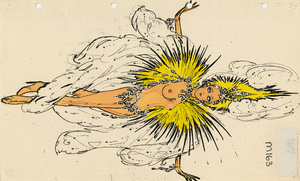
Costume design drawing, topless showgirl in yellow and black feathers #5, Las Vegas, June 5, 1980
Date
1980-06-05
Archival Collection
Description
Pete Menefee design. Transcribed from original drawing index: "tall nude girl (yellow & black feathers #5)."
Costume Details: Topless showgirl in jeweled g-string and headress with yellow, white, and black feathers.
Show Name: Jubilee!
Performance Name: Minstrel opening: Hullabaloo
Site Name: MGM Grand Hotel and Casino
Costume Details: Topless showgirl in jeweled g-string and headress with yellow, white, and black feathers.
Show Name: Jubilee!
Performance Name: Minstrel opening: Hullabaloo
Site Name: MGM Grand Hotel and Casino
Image
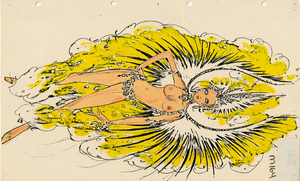
Costume design drawing, topless showgirl in yellow and black feathers #6, Las Vegas, June 5, 1980
Date
1980-06-05
Archival Collection
Description
Pete Menefee design. Transcribed from original drawing index: "tall nude girl (yellow & black feathers #6)."
Costume Details: Topless showgirl in jeweled g-string and headress with yellow, white, and black feathers.
Show Name: Jubilee!
Performance Name: Minstrel opening: Hullabaloo
Site Name: MGM Grand Hotel and Casino
Costume Details: Topless showgirl in jeweled g-string and headress with yellow, white, and black feathers.
Show Name: Jubilee!
Performance Name: Minstrel opening: Hullabaloo
Site Name: MGM Grand Hotel and Casino
Image
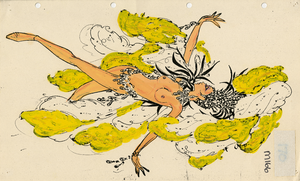
Costume design drawing, topless showgirl in yellow and black feathers #8, Las Vegas, June 5, 1980
Date
1980-06-05
Archival Collection
Description
Pete Menefee design. Transcribed from original drawing index: "tall nude girl (yellow & black feathers #8)."
Costume Details: Topless showgirl in jeweled g-string and headress with yellow, white, and black feathers.
Show Name: Jubilee!
Performance Name: Minstrel opening: Hullabaloo
Site Name: MGM Grand Hotel and Casino
Costume Details: Topless showgirl in jeweled g-string and headress with yellow, white, and black feathers.
Show Name: Jubilee!
Performance Name: Minstrel opening: Hullabaloo
Site Name: MGM Grand Hotel and Casino
Image
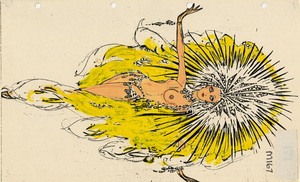
Costume design drawing, topless showgirl in yellow and black feathers #9, Las Vegas, June 5, 1980
Date
1980-06-05
Archival Collection
Description
Pete Menefee design. Transcribed from original drawing index: "tall nude girl (yellow & black feathers #9)."
Costume Details: Topless showgirl in jeweled g-string and headress with yellow, white, and black feathers.
Show Name: Jubilee!
Performance Name: Minstrel opening: Hullabaloo
Site Name: MGM Grand Hotel and Casino
Costume Details: Topless showgirl in jeweled g-string and headress with yellow, white, and black feathers.
Show Name: Jubilee!
Performance Name: Minstrel opening: Hullabaloo
Site Name: MGM Grand Hotel and Casino
Image
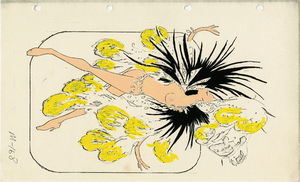
Costume design drawing, topless showgirl in yellow and black feathers #10, Las Vegas, June 5, 1980
Date
1980-06-05
Archival Collection
Description
Pete Menefee design. Transcribed from original drawing index: "tall nude girl (yellow & black feathers #10)."
Costume Details: Topless showgirl in jeweled g-string and headress with yellow, white, and black feathers.
Show Name: Jubilee!
Performance Name: Minstrel opening: Hullabaloo
Site Name: MGM Grand Hotel and Casino
Costume Details: Topless showgirl in jeweled g-string and headress with yellow, white, and black feathers.
Show Name: Jubilee!
Performance Name: Minstrel opening: Hullabaloo
Site Name: MGM Grand Hotel and Casino
Image
Pagination
Refine my results
Content Type
Creator or Contributor
Subject
Archival Collection
Digital Project
Resource Type
Year
Material Type
Place
Language
Records Classification
